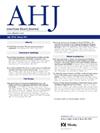重度主动脉瓣狭窄患者的转诊模式和临床结果:一项多中心队列研究
IF 3.5
2区 医学
Q1 CARDIAC & CARDIOVASCULAR SYSTEMS
引用次数: 0
摘要
背景:严重主动脉瓣狭窄(AS)患者需要心脏科专家及时随访和主动脉瓣置换术(AVR)。这项多中心研究评估了预定初始超声心动图(echo)的提供者的专业如何影响这些终点。方法:2019年1月1日至2022年12月31日,来自三个卫生系统的首次超声心动图诊断为严重AS的患者,根据订购超声的提供者的专业进行分类。终点包括早期心脏随访或AVR(90天内)、随访期间AVR和死亡率的综合结果。使用Logistic回归和Cox比例风险模型来确定与终点相关的因素。结果:4249例患者(77岁;男性58%;88%的白人;72%有症状的AS)随访时间中位数为552天。89%的患者达到了复合结果,但1801例患者(42%)在随访期间未接受AVR治疗,其中包括32%的有症状患者。由非心脏专科医生转诊的患者早期心脏随访率或AVR较低(调整or: 0.33, 95%CI: 0.25-0.43), AVR较低(调整HR: 0.59, 95%CI: 0.53-0.66),死亡率较高(调整HR: 1.65;95%CI: 1.44-1.90)与由心脏病学提供者转诊的患者相比;这种差异在低流量低梯度AS患者中更为明显。结论:在这项针对严重AS患者的大型多中心研究中,非心脏专科医生的患者接受及时心脏随访和AVR的可能性较低,死亡率较高。需要采取行动,解决这一高危人群在护理方面的差异并改善结果。本文章由计算机程序翻译,如有差异,请以英文原文为准。
Referral patterns and clinical outcomes in patients with severe aortic stenosis: A multicenter cohort study
Background
Patients with severe aortic stenosis (AS) require timely follow-up by cardiac specialists and aortic valve replacement (AVR). This multicenter study evaluates how the specialty of the provider who ordered the initial echocardiogram influences these endpoints.
Methods
Patients from 3 health systems with a first echocardiogram (index echo) diagnosing severe AS from Jan 1, 2019 to Dec 31, 2022, were categorized based on the specialty of the provider ordering the echo. Endpoints included a composite outcome of early cardiac follow-up or AVR (within 90 days), AVR during follow-up, and mortality. Logistic regression and Cox proportional hazard models were used to identify factors associated with the endpoints.
Results
4,249 patients (77 years; 58% male; 88% white; 72% symptomatic AS) were followed for a median of 552 days. Eighty-nine percent of patients achieved the composite outcome, yet 1,801 patients (42%) did not receive an AVR during the follow-up period, including 32% of symptomatic patients. Patients referred for the index echo by noncardiac specialty providers had lower rates of early cardiac follow-up or AVR (adjusted OR: 0.33, 95% CI, 0.25-0.43), lower AVR rates (adjusted HR: 0.59, 95% CI, 0.53-0.66), and higher mortality (adjusted HR: 1.65; 95% CI, 1.44-1.90) compared to the patients referred by a cardiology provider; the discrepancy was more pronounced in patients with low-flow, low-gradient AS.
Conclusion
In this large multicenter study of patients with severe AS, patients with a noncardiac specialty provider were less likely to receive timely cardiac follow-up and AVR, and had higher mortality. Initiatives to address disparities in care and improve outcomes for this high-risk population are needed.
求助全文
通过发布文献求助,成功后即可免费获取论文全文。
去求助
来源期刊

American heart journal
医学-心血管系统
CiteScore
8.20
自引率
2.10%
发文量
214
审稿时长
38 days
期刊介绍:
The American Heart Journal will consider for publication suitable articles on topics pertaining to the broad discipline of cardiovascular disease. Our goal is to provide the reader primary investigation, scholarly review, and opinion concerning the practice of cardiovascular medicine. We especially encourage submission of 3 types of reports that are not frequently seen in cardiovascular journals: negative clinical studies, reports on study designs, and studies involving the organization of medical care. The Journal does not accept individual case reports or original articles involving bench laboratory or animal research.
 求助内容:
求助内容: 应助结果提醒方式:
应助结果提醒方式:


